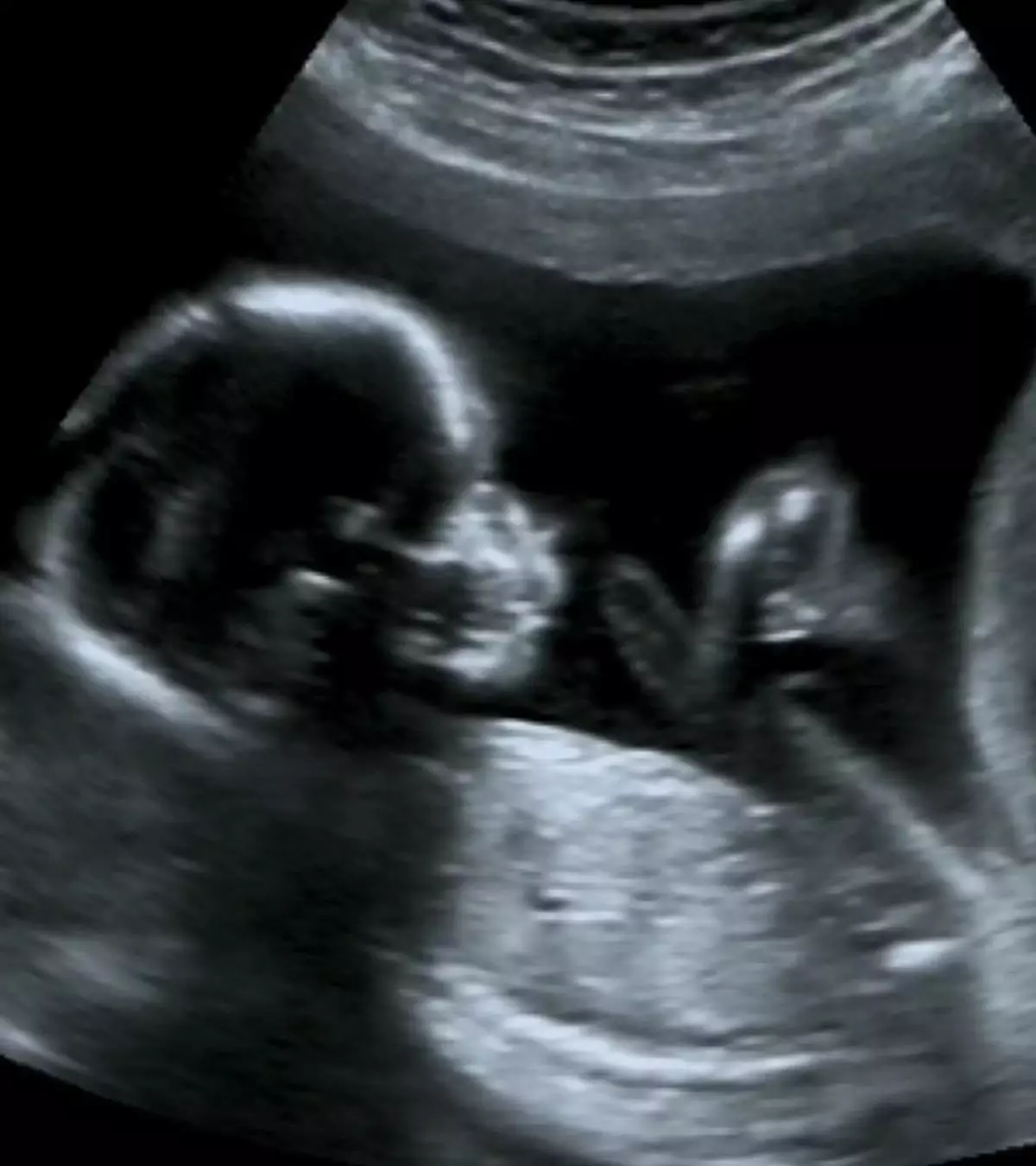
Image: Shutterstock
Fetal growth restriction (FGR) is a condition in which the baby does not develop to its optimum growth and weight during pregnancy.
The common reasons for this condition include high blood pressure of the mother, multiple pregnancies, infections, and consumption of alcohol or smoking during pregnancy. Therefore, it is important to regularly monitor the growth and development of the baby during this period to avoid any complications.
Read on to know about FGR, its causes, symptoms, treatment, and preventive measures.
Key Pointers
- Fetal Growth Restriction (FGR) or Intrauterine Growth Restriction (IUGR) refers to slow fetal growth during pregnancy.
- IUGR can be caused by maternal, fetal, or placental factors.
- Maternal factors such as gestational hypertension, infections, and low amniotic fluid levels, can contribute to IUGR.
- Other contributing factors to IUGR include multiple pregnancies, placental insufficiency, and umbilical abnormalities.
- Lifestyle factors of the mother, such as smoking, drinking alcohol, and drug usage, can also cause IUGR.
- Babies with IUGR have a higher risk of pre/post birth issues such as low birth weight, breathing/feeding problems, neurological issues, and low Apgar score.
What Is Fetal Growth Restriction?
Intrauterine growthiDevelopment of the fetus within the uterus restriction (IUGR), is a condition which is applied for neonates born with clinical signs of retarded or abnormal fetal development and fetal malnutrition. In this condition, the size of the baby is smaller than the average size at that age.
Different types of IUGRs during pregnancy
There are two main types of intrauterine growth restrictions occurring during pregnancy:
- Symmetrical or primary IUGR: The baby has a symmetrical body in proportion with the internal organs, but is smaller than the size of a normal baby of that age.
- Asymmetrical or secondary IUGR: The baby has a normal head and brain, but the body is small for gestational age. This condition is not evident until the third trimester.
 Did you know?
Did you know?IUGR could be the result of certain health issues in the mother.
Reasons For Restricted Growth Of Fetus During Pregnancy
The causes of IUGR are segregated into three broad categories: maternal, fetal and placentaliIt is a temporary vascular organ that grows during pregnancy and provides the growing fetus with oxygen and nutrition (1).
- Maternal health is important for the baby to get all the essential nutrients for its growth.
- Fetal health is necessary to make sure the baby receives the nutrients supplied by the mother.
- The placenta should be healthy enough to carry the nutrients from the mother to the fetus.
All the factors mentioned below fall into one of the three categories:
- Pregnancy-induced hypertension: During pregnancy, your blood pressure is constantly monitored to check for hypertension. An increased blood pressure may indicate hypertensive disorder of pregnancy (gestational hypertension, chronic hypertension preeclampsia). The reduced placental blood flow cuts down on the supply of sufficient oxygen and supplements to the fetus, thereby leading to fetal hypoxemia and fetal growth retardation, known as placental dysfunction (2). It may also cause preterm birth and fetal distress. Fetal Anemia can also be the reason for fetal distress.

- Multiple pregnancies: In some cases of multiple pregnancies, the slow fetal development is because of the placental insufficiency to meet the nutritional demands of multiple babies. Moreover, the chances of hypertensive disorder are also high in multiple pregnancies. IUGR occurs in 25-30% of twin pregnancies (3).
- Infections: Any infections transferred from the mother during pregnancy can lead to slow fetal growth. Infections such as syphilis (a sexually transmitted bacterial infection), toxoplasmosis (a parasitic infection transmitted mainly through under-cooked meat), cytomegalovirus (viral infection with significant impact during pregnancy due to weaker immunity), and German measles or rubella in pregnancy increase the chances of IUGR (4).

- Lower level of amniotic fluids: It is necessary to have sufficient amniotic fluid in the sac for normal fetal development to happen. However, low fluid level (also termed as oligohydramnios) can lead to fetal growth restriction (5). Various factors, including the health of the mother, certain medications, and a slight rupture of the amniotic sac cause the fluid levels to deplete.
- Placental insufficiency: In this condition, the placenta does not work properly. This leads to insufficient oxygen supply and inadequate fetal nutrition from the mother, resulting in slow growth (6).
- Abnormalities of the umbilical cord: The cord connects the fetus with the placenta during pregnancy. It contains one umbilical vein and two umbilical arteries, which carry blood between the fetus and the placenta. However, if there is only one artery in the umbilical cord, then this abnormality leads to fetal growth restriction (7).
7. Other maternal and fetal reasons include:
- Small size of the mother, leading to constitutionally small baby
- The mother’s nutritional intake during pregnancy
- Abnormal shape or size of the womb
- Chronic illness in the mother such as sickle cell disease, diabetes, hypertension, heart disease
- Chromosomal abnormalities
- Genetic and skeletal abnormalities in the fetus.
 Be watchful
Be watchfulSlow fetal growth can also occur due to the lifestyle of the mother, such as if she:
- smokes
- is underweight (maternal undernutrition)
- drinks alcohol
- takes drugs
- follows poor diet
- is exposed to high doses of radiation or chemicals (8)
 Quick fact
Quick factDuring your antenatal checkup, the doctor will measure the fundal heightiThe distance between the pubic bone and the top of the uterus, used to track the fetal growth throughout pregnancy to determine the size of the baby.
Your baby’s size will be monitored throughout the pregnancy, and the measurements will be put on a growth chart. If the doctor finds any abnormality, she does an ultrasound scan to measure the baby’s growth accurately.
Fetal growth measurement is important because slow growth could lead to certain health problems in the baby.
Risks of IUGR

Babies with IUGR have increased chances of getting health issues both before and after birth. The risks include (9) (10):
- Reduced fetal weight or Low birth weight
- Problems with breathing and feeding
- Decreased ability to fight infection
- Fetal Hypoglycemia (low blood sugar level)
- Fetal hypoxia
- Fetal Asphyxia
- Intrauterine hypoxia
- Low Apgar Scores (Apgar score is a test carried out to evaluate the physical condition of the newborn and to determine any immediate need of medical care. The score is determined on a scale of 0 to 2, with 2 being the best)
- Abnormally high red blood cell count
- Neurological problems
- Trouble in maintaining the body temperature
- Stillbirth
In order to avoid these risks in the baby, the doctor conducts a regular fetal growth scan during pregnancy health check-ups.
How Is Fetal Growth Restriction Diagnosed?
The fetal size can be estimated by measuring the fundal height. However, there are other procedures to diagnose IUGR and assess the baby’s health:
- Ultrasound: An ultrasound uses sound waves to create images of the baby’s structure and measure its head and abdomen. These measurements are compared with the growth chart to estimate the fetal weight.

- Doppler flow: The technique is used to measure the speed and amount of blood flow into the blood vessels of the fetal brain and the umbilical cord, using sound waves.
- Weight checks: It is another way of estimating the fetal growth. During every prenatal visit, the doctor will check and record the mother’s weight. If the expecting woman is not gaining appropriate weight, it could result in the fetus’ slow growth. Slow fetal growth can be effectively managed in expecting mothers through regular checkups and a healthy lifestyle.
A mom-blogger shared her journey of carrying a baby with intrauterine growth retardation in her blog, ‘Lanonativa.’ She recounts, “My baby had an intrauterine growth retardation. He was always a lot below the average, but the doctor was great and he used to say: you are going to have a Ferrari, small but powerful. As I had a very difficult pregnancy and it was very important to check the fetal growth, every two weeks the obstetrician measured abdominal circumference, head circumference, femur, biparietal diameter, and occipital frontal diameter.
“I think that normally if everything is going fine, the visits to the doctors are just once a month or even less, but as I haven’t had any other pregnancy I am not sure if every time you go, they measure all these things, I don’t think so (i).”
How is IUGR managed?
IUGR is managed based on its severity. It depends on the gestational age at which it is diagnosed. IUGR can be divided into early onset IUGR and late onset IUGR, depending on whether its occurring prior to 34 weeks or after that. According to the fetal compromise, IUGR is divided into stages I-IV based on the effective fetal weight, cerebroplacental ratioiAn ultrasound tool used to predict an adverse pregnancy outcome , uterine artery PIiA technique to evaluate fetal well-being by calculating the pulsation in the uterine artery , flows in ductous venosus and management based upon the stage and gestational age at diagnosed management can be planned.
- Stage 0: You are treated as an outpatient with a Doppler test done every two weeks. If the results are consistent, your delivery can be at term. But if the Doppler results are abnormal, the fetus moves to Stage I.
- No IUGR: Where the baby is constitutionally small but the doppler parameters are normal, pregnancy can be taken until 40 weeks. Labor may be induced at 40 weeks if the patient does not go into labor by 40 weeks and there are no contraindications for normal vaginal delivery. If the gestational age is less than 40 weeks, the mother is monitored weekly until 40 weeks and induction is done earlier in the case of any deterioration.
- Stage I: Weekly monitoring is required until 37 weeks and induction for labor is done if no contraindications for normal vaginal delivery.
- Stage II: Stricter monitoring is needed every two to three days. Delivery is done by cesarean section (CS) as the baby is unable to withstand the stress of labor. This is usually advised at 34 weeks.
- Stage III: Monitoring every 24-48 hours and mode of delivery is usually via CS usually at 30 weeks after steroid cover.
- Stage IV: Monitoring every 12-24 hours and delivery via CS at gestational age more than 26 weeks. Long-term prognosis remains poor due to extreme prematurity.
If your doctor suspects IUGR, then:
- You will have regular scans to check your baby’s growth. With a Doppler test, the amount of blood flow from the placenta to the fetus is checked.
- If there is any concern about the fetal growth, your doctor will recommend CTG monitoring, regular scans, and consultant appointments.
- You will be advised to monitor the movements of your baby closely.
- If growth restriction is severe, then the doctor may recommend an early delivery by C-section as vaginal delivery would be stressful (11). In such a case, your baby will be put in the neonatal care unit, where it can grow better than inside your womb.
Above all, you need to take care of yourself by eating nutritious food and taking ample rest.
What should you do in the case of IUGR?
Visit your doctor regularly and get carefully checked. Closely monitor your baby’s movement patterns. If your baby does not move very often, contact your doctor and follow their instructions.
Ask your doctor several questions such as,
- What activities should you avoid?
- What precautions should you take?
- What symptoms or problems should you watch out for?
There is little you can do to control IUGR, but certain lifestyle changes could be of help.
How to prevent IUGR?

The below measures can reduce the risk of IUGR:
- Eat a healthy diet. Healthy foods provide proper nourishment to your baby.
- Quit smoking and drinking alcohol during pregnancy.
- Limit the intake of caffeine.
- Check with your doctor if any medications that you are taking pose a risk of IUGR.
- Get plenty of rest and keep stress at bay. Try to get at least eight hours of sleep every day.
- Stay fit by exercising.
Frequently Asked Questions
1. Can you have a healthy baby with IUGR?
Yes. There are no mental complications associated with IUGR other than slow or restricted fetal growth. Additionally, with proper care and nutrition, most IUGR babies can grow into healthy children and adults (13).
2. How can I increase fetal growth?
Including increased consumption of fruits and vegetables and vitamin C in your diet throughout pregnancy can promote an increase in fetal growth, especially from mid-pregnancy. Studies show that this diet can aid in fetal and infant growth up to six months (14).
3. Can fetal growth restrictions cause miscarriage?
According to studies, fetal growth restrictions in the first trimester are associated with an increased risk of subsequent miscarriages (15).
4. Does bed rest help with fetal growth restriction?
Some studies showed that bed rest might improve fetal growth by increasing blood flow to the uterus, while others found no significant benefits. Overall, there’s inadequate evidence to prove that bed rest can help with fetal growth restriction (16).
Pregnancy-related maternal, fetal, or placental complications may lead to fetal growth restriction. Babies with intrauterine growth restriction are more at risk of complications before and after birth. Though this condition is not completely controllable, you may practice a healthy diet, lifestyle, regular physical activity, avoid smoking and alcohol consumption while pregnant to reduce the risk. Also, it is essential to undergo regular checkups during pregnancy to assess the baby’s growth. Further, communicate to your doctor about your concerns and follow their instructions. However, if your fetal growth remains slow, you can wait for their birth. After that, breastfeed and carefully nurture them to facilitate their growth and development.
Infographic: How To Prevent Intrauterine Growth Restriction?
Fetal growth restriction is when a baby is not growing properly in the womb. Following simple yet critical measures highlighted in this infographic is essential to prevent this phenomenon. Also, attend regular prenatal checkups and follow your doctor’s advice for a healthy pregnancy and baby. Illustration: Momjunction Design Team
Fetal Growth Restriction is a serious condition that can affect a baby’s growth. Learn about its different types, various reasons that cause this condition, TORCH infections, diagnosis, and treatment of FGR.
Personal Experience: Source
MomJunction articles include first-hand experiences to provide you with better insights through real-life narratives. Here are the sources of personal accounts referenced in this article.
i. What should my baby measure now? Fetal growth standards;https://lanonativa.blogspot.com/2016/08/what-should-my-baby-measure-now-fetal.html
References
- Intrauterine Growth Restriction: When Your Baby Stops Growing Before Birth.
https://www.aafp.org/pubs/afp/issues/1998/0801/p466.html - Parvin Niknafs; (2000); Identification of intrauterine growth restricted babies: development of an IUGR index.
https://ro.uow.edu.au/cgi/viewcontent.cgi?referer=&httpsredir=1&article=2614&context=theses - S K Srinivas et al.; (2009); Rethinking IUGR in preeclampsia: dependent or independent of maternal hypertension?
https://www.ncbi.nlm.nih.gov/pmc/articles/PMC2834367/ - Giuseppe Puccio et al.; (2014); Intrauterine growth pattern and birthweight discordance in twin pregnancies: a retrospective study.
https://www.ncbi.nlm.nih.gov/pmc/articles/PMC4018970/ - Giuseppe Puccio et al.; Intrauterine growth pattern and birthweight discordance in twin pregnancies: a retrospective study.
https://pubmed.ncbi.nlm.nih.gov/24887062/ - Maryam Asgharnia et al.; (2013); Perinatal outcomes of pregnancies with borderline versus normal amniotic fluid index.
https://www.ncbi.nlm.nih.gov/pmc/articles/PMC3941328/ - Placental Insufficiency.
https://www.birthinjuryguide.org/causes/placental-insufficiency/ - Umbilical cord abnormalities.
https://www.marchofdimes.org/find-support - Li Chi Chew and Rita P. Verma; (2021); Fetal Growth Restriction.
https://www.ncbi.nlm.nih.gov/books/NBK562268/ - Zohra S Lassi et al.; (2014); Preconception care: caffeine smoking alcohol drugs and other environmental chemical/radiation exposure.
https://www.ncbi.nlm.nih.gov/pmc/articles/PMC4196566/ - Gregory A Lodygensky et al.; (2008); Intrauterine Growth Restriction Affects the Preterm Infant’s Hippocampus.
https://idp.nature.com/authorize?response_type=cookie&client_id=grover&redirect_uri=https%3A%2F%2Fwww.nature.com%2Farticles%2Fpr200888 - Effects of intrauterine growth retardation on mental performance and behavior outcomes during adolescence and adulthood.
https://archive.unu.edu/unupress/food2/UID03E/UID03E0Q.HTM - IUGR—Why Is My Baby Small and What Can Be Done About It?
https://www.aafp.org/pubs/afp/issues/1998/1015/p1393.html - Won Jang et al.; (2018); Maternal fruit and vegetable or vitamin C consumption during pregnancy is associated with fetal growth and infant growth up to 6 months: results from the Korean Mothers and Children’s Environmental Health (MOCEH) cohort study.
https://nutritionj.biomedcentral.com/articles/10.1186/s12937-018-0410-6 - Hurunor Rashid et al.; (2017); First- trimester fetal growth restriction and the occurrence of miscarriage in rural Bangladesh : A prospective cohort study.
https://www.ncbi.nlm.nih.gov/pmc/articles/PMC5521847/ - Li Chi Chew and Rita P. Verma; (2021); Fetal Growth Restriction.
https://www.ncbi.nlm.nih.gov/books/NBK562268/
Community Experiences
Join the conversation and become a part of our nurturing community! Share your stories, experiences, and insights to connect with fellow parents.
Read full bio of Dr. Asmita Kaundal
Read full bio of shreeja pillai
Read full bio of Swati Patwal
Read full bio of Lorraine Teron



















